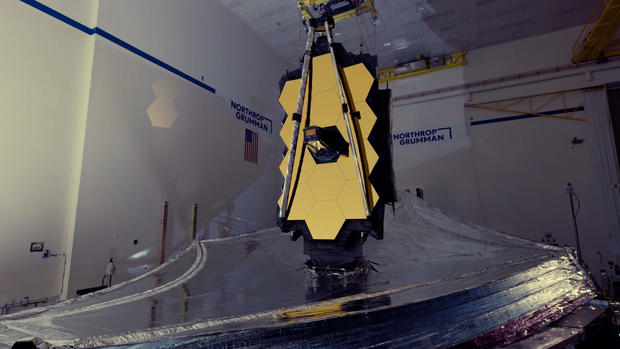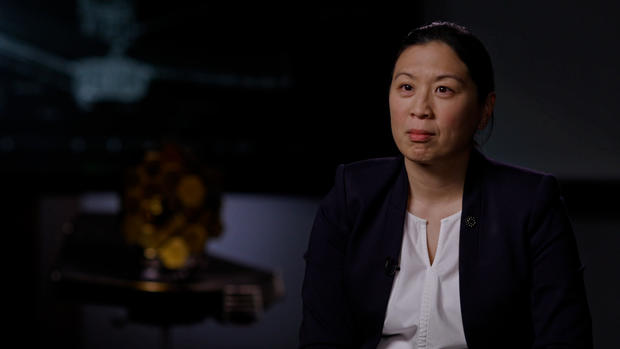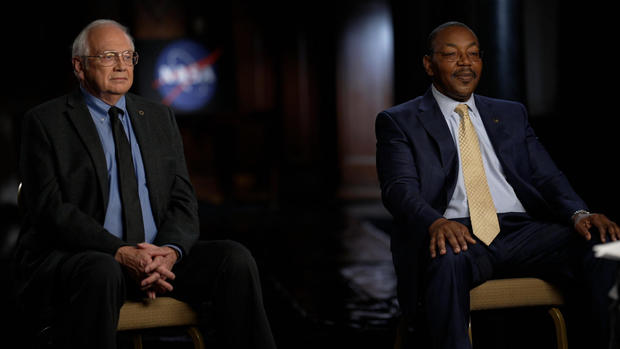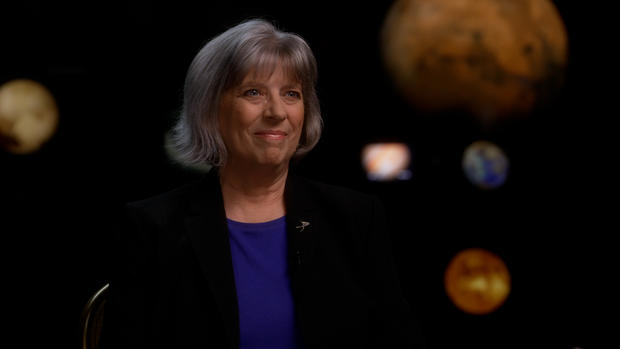James Webb Space Telescope: Looking back in time to catch the earliest starlight in creation
This December 22, may become known as the day the universe changed. That Wednesday, NASA expects to launch the James Webb Space Telescope, the largest and most expensive instrument ever flown. One hundred times more powerful than the 31-year-old Hubble Telescope, Webb can see back in time all the way to the "let there be light" moment—that instant when a cold, dark universe ignited into stars.
Scott Pelley: Wow. Well, somehow, that's a lot bigger than I imagined.
Amy Lo: She's a big one.
A year ago, we were among the last humans to see the telescope much as it will appear in space. After our visit, it was packed away for a journey of a million miles, far beyond the moon, to lie forever in the grasp of the sun.
Scott Pelley: The operating life is how long?
Amy Lo: It's designed for five and a half years with a goal of ten years. So that means we carry enough stuff on there to last for ten years.
Amy Lo is a systems engineer who took us up in the clean room at Northrop Grumman in Redondo Beach, California.
Amy Lo: We had to invent it, design it, build it and hand put it together.
At the bottom of the spacecraft, that silver shroud is a parasol, big as a tennis court, to shield Webb from the sun. Above, there are 21 feet of gold-plated mirrors, six times bigger than Hubble's mirror, to catch the earliest star light in creation.
Scott Pelley: There are 18 of these hexagonal mirrors. But when you fold them out, they all work in concert as one mirror?
Amy Lo: That's right. All 18 images will form one very nice, solid image.
That image would be invisible to the human eye. Like a night vision camera, Webb is designed to see heat - infrared light - because that's the only signature left from the stars at the edge of time. Even that glow will be so dim the mirrors will have to squint for hours to expose an image.
Scott Pelley: How much confidence do you have?
Amy Lo: You know my job is to worry. I personally feel confident that we have thought of everything.
Thinking of everything took more than 25 years and $10 billion. Engineer Amy Lo explained the challenge.
Amy Lo: In my mind the biggest engineering challenge was to build a sunshield capable of shielding the optics, the mirrors and the instrument on Webb. How do you build something big, but lightweight?
The sunshield keeps Webb cold and dark. Any infrared heat from the sun or earth would blind the telescope. The five layers are made of gossamer sheets not unlike mylar birthday balloons.
Amy Lo: The layer facing the sun is layer one, and layer one reaches about 230 degrees Fahrenheit. So, a pretty warm oven, like, if you wanted to cook a meringue, or something.
Scott Pelley: And on the telescope side?
Amy Lo: On the telescope side, it gets to negative 370 degrees Fahrenheit.
Scott Pelley: There's a roughly 600-degree difference between one side of the heat shield and the other.
Amy Lo: Yes, it's amazing that it's able to do this with nothing more than these layers.
The engineering is amazing, but the science may reveal the universe. Since the beginning, the Big Bang, the arrow of time has flown nearly 14 billion years. Webb, may see all the way back to the first 100 million—the baby universe. Amber Straughn is an astrophysicist on the project.
Amber Straughn: Telescopes really are time machines, they literally allow us to see into the past. And the reason for that is just due to the nature of how light travels. light from the sun takes about eight minutes to get to the earth. So, we're seeing the sun as it was eight minutes ago. And you can sort of think about stepping that further out into the universe.
Scott Pelley: So, when we walk out under the stars, and look above us, we're not seeing the stars as they are today. We're seeing them as they were perhaps millions of years ago.
Amber Straughn: Absolutely.
Scott Pelley: Because it took that long for the light to reach the earth.
Amber Straughn: Yes, for sure.
Scott Pelley: How much do we know about the universe?
Amber Straughn: everything we know about, everything we can see, me and you, everything on the planet, all the hundreds of billions of other galaxies, all of that only makes up about 5% of the universe. The rest of it, that other 95%, we have no idea what it is.
That 95% --the unknown--is all around us like a ghost. Nearly all the cosmos is made up of what physicists call, in desperation, dark matter and dark energy. Never seen, scientists infer they must exist because they're the best explanation for how galaxies form and move.
Amber Straughn: So, we know that dark matter is sort of this scaffolding of the universe. It's the—the structure on which galaxies sit. And if there wasn't dark matter, there wouldn't be galaxies and there wouldn't be us.
Scott Pelley: What might the Webb Telescope reveal about dark matter?
Amber Straughn: It's like we have this 14-billion-year-old story of the universe, but we're missing that first chapter. And Webb was specifically designed to allow us to see those very first galaxies that formed after the Big Bang. Now, galaxies are born and then they evolve, they change over time, and this way that galaxies change must rely critically on dark matter. And Webb is going to allow us to observe that process of galaxy evolution in much more detail.
The promise of discovery shielded Webb on what's already been a treacherous journey. It was to launch 7 years ago but delays come with a machine this ambitious. Because of cost overruns, Webb was cancelled, in 2011, by the House Appropriations Committee, but it was saved in the Senate. Its namesake is James Webb, head of NASA in the 1960s who made science a top priority.
Scott Pelley: What are the stakes, what's riding on that rocket with Webb?
Bill Ochs: When you talk about what's at stake, it really is NASA's reputation, to take on a mission that is as challenging as Webb and be successful.
Bill Ochs and Greg Robinson run the program. Ochs was an engineer on Hubble. Robinson has supervised NASA quality and performance.
Greg Robinson: If you want to be bold and get the kinda science we're after, you have to make the investment. And it's gonna answer two big questions for astrophysics, where did we come from, and are we alone? And we're looking forward to getting those results.
Scott Pelley: Is Webb gonna work?
Greg Robinson: Yes, it's gonna work. I have very high confidence.
Bill Ochs: I am 100% confident.
Scott Pelley: Why 100% confident?
Bill Ochs: 'Cause when I look at the testing that we have done over the years, and the type of engineering that went into it, you build a sense of confidence that you know this is going to work.
Scott Pelley: What are you most concerned about?
Bill Ochs: Unfolding the entire telescope is what you worry about.
The observatory had to be folded into an Ariane 5 rocket just 16-feet-wide, it's wrapped today tight as a rose bud. In flight, more than 40 systems must blossom with perfection. Including Amy Lo's never-invented-before sun shield.
Scott Pelley: All five layers will be folded up and held in place by pins. How many pins are there?
Amy Lo: There's 107 of these membrane release devices and pins that hold all five layers pinned to this structure here called a UPS. All total, 107.
Scott Pelley: And as you're unfolding, how many of those can fail?
Amy Lo: None.
Scott Pelley: None?
Amy Lo: None.
Scott Pelley: Not one?
Amy Lo: Not one.
Scott Pelley: There is literally no room for error.
Amy Lo: We test and we do a lot of analysis to ensure that each and every single one of these will release on orbit.
$10 billion rides on those pins. The Hubble Telescope, 340 miles up, could be reached with a wrench. Webb at a million miles, is beyond repair. Bill Ochs told us that if something does get stuck, there is an emergency plan.
Bill Ochs: We've developed algorithms, to essentially, we call it the shimmy, we do a little shake on the telescope, and we can rock it back and forth. If that doesn't work, we have another one we call the twirl, which can actually spin the telescope either clockwise or counterclockwise, to help shake things loose.
Scott Pelley: So you're gonna do what I do with devices when they're not working, you're gonna shake it.
Bill Ochs: Yeah, yeah, kinda do the same thing, yes.
If 107 pins release, the mirrors synchronize, and 10,000 things go right, Webb will be limited only by about10 years of fuel for pivoting and pointing. Canada contributed the aiming system that will guide Webb to wonders far and near. More than a thousand astronomers around the world are competing for telescope time. Heidi Hammel was granted 100 hours.
Heidi Hammel: I have so many questions. My particular focus is objects in our solar system.
Hammel told us that light is full of information. Webb can define the chemistry of a place by analyzing its wavelengths of light.
Heidi Hammel: What is the atmospheric water content of Mars and how does it change with time?
What drives the chemistry in the upper atmosphere of Neptune? Can we see if there's water coming out of the moons of Jupiter or Saturn? There are just an infinite number of questions I wanna answer.
Astrophysicist Natalie Batalha, also has time on Webb. She'll be looking at planets beyond our solar system.
Natalie Batalha: On average, every star in the galaxy has at least one planet. That means that there are more planets in the galaxy than there are stars. Hundreds of billions of planets.
And with that many planets, Batalha is sure Webb could find some with the chemistry and conditions of life.
Natalie Batalha: There happens to be one planetary system, the star has seven planets orbiting it. And the star is only about 40 light years away, so it's a great target to study. And it has three Earth-sized planets orbiting in what I would call the Goldilocks Zone where life could potentially exist.
Scott Pelley: Not too hot, not too cold.
Natalie Batalha: That's the idea. Yes. And so this is also one of the very first targets that we're going to observe with Webb. And what we'll be able to see is, is there carbon dioxide in the atmosphere? What are the greenhouse gasses? Is there carbon dioxide in combination with methane because that's what Earth has. So, by looking at these chemical constituents, we might be able to piece together if it's not just a planet in what we call the "Habitable Zone," but if it's truly a habitable environment.
Scott Pelley: And somebody might ask, "Why does it matter?"
Natalie Batalha: The end point is to put an end to our cosmic loneliness. We want to know if there's life out there.
Scott Pelley: From a researcher's perspective, is Webb evolutionary or revolutionary?
Natalie Batalha: Every time you put a new piece of technology into space, or you look at the universe with different eyes, you-- you learn something revolutionary. Something that you couldn't have even predicted. I don't know what those surprises are going to be, but the technology is revolutionary. And there will be tremendous surprises that will astound us.
Webb is on the doorstep, aboard a European space agency rocket. Some, including Amy Lo, may hold their breath as it unfolds itself on the month-long journey to its station around the sun. The first images, in six months or so, will be converted from invisible infrared into pictures suitable for headlines. Chances are, what we see, we will not understand—the very definition of wonder.
Produced by Aaron Weisz. Associate producer, Ian Flickinger. CBS News Space Analyst, William Harwood. Broadcast associate, Michelle Karim. Edited by Michael Mongulla.










